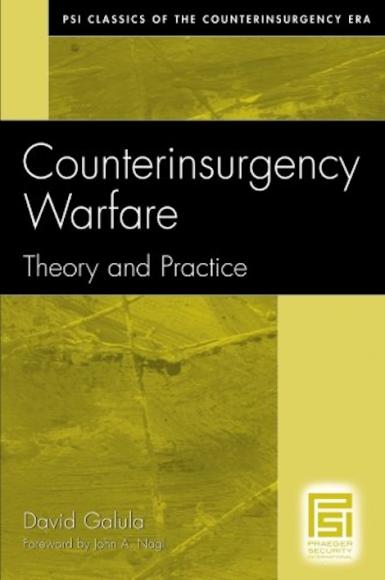David Galula, Counterinsurgency Warfare. Theory and Practice
Ed. Prager Security International, 20062
pp.128
Published for the first time in the 1964 by Praeger Security International, Counterinsurgency Warfare. Theory and Practice by David Galula, a former lieutenant colonel of the French army who settled in the United States in the early sixties of the last century, is one of the classics of the so-called French doctrine of the revolutionary war, although the work has had its spread over the years almost exclusively in the military institutions of the United States, so much so as to become one of the reference works of the modern American counterinsurgency doctrine (COIN) and to be the main source of the US army manual on counterinsurgency, theUS Army / Marine Corps Counterinsurgency Field Manual 3-24, published in 2006.
The edition of the volume that we review here is the one published in 2006, again for the types of Praeger International, with a new preface due to John A. Nagl, a former US Army Lieutenant Colonel, author of counterinsurgency studies in Malaysia and Vietnam, as well as one of the authors of the aforementioned Coin manual.
The Author defines the specific laws of counterinsurgency and outlines the strategy and tactics to overcome this kind of conflict on the basis of the experiences and observations on the field that he had gained in fighting the revolutionary wars on three continents, Europe, China Africa, but recurring also to specific historical examples.
The first three chapters constitute the introduction to the book, which analyzes the characteristics of the "revolutionary war" ─ which is defined by Galula as "a clash between counterinsurgency forces and insurrectional forces ─, the conditions for the victory of insurgents and the advocated insurrectionary doctrine. According to Galula the revolutionary war can originate only on the initiative of the insurgents, since the counterinsurgency is only a consequence of the insurrection.
Paraphrasing Clausewitz's famous maxim, Galula defines the insurrection as "the pursuit of the politics of a party in a given country by every possible means"(P.1), but specifies that the insurgency is not, like a conventional war, the"continuation of policy by other means", since"an insurrection can begin long before insurgents resort to the use of force". Galula also echoes the Maoist doctrine where it states that an insurgency is "a long-term struggle conducted methodically, step by step, in order to reach specific intermediate targets that eventually lead to the overthrowing of the existing order"(P.2).
For Galula the peculiar characteristic of the revolutionary war, in which the insurgents maintain the strategic initiative, lies in its asymmetry. Government forces have an overwhelming superiority in terms of material resources, while the situation is reversed in the field of intangible resources. Through the powerful resource represented by being supporters of a strong political cause, insurgents are able to convert their intangible assets into material resources.
The essential prerequisites for conducting a winning insurrectionary strategy are an ideology capable of mobilizing the civilian population, an inefficient public administration, a favorable or not too hostile geographical environment, and external support.
The author then analyzes two insurrectional models: the first, called "orthodox" or communist, is characterized by the presence of a strong revolutionary party, which aims to seize power to carry out a radical communist transformation of society, while the second, called the "bourgeois-nationalist model", is based essentially on the blind and selective terrorism practiced by a small revolutionary nucleus, whose immediate goal and the conquest of power for power, in order to break the link between the population and the government .
From the perspective of counterinsurgents, the revolutionary war can be divided into two phases: the cold one defined (cold revolutionary war), when the activities of insurgents remain within the limits of legality; and the hot one (hot revolutionary war), when it becomes openly illegal and violent. From these two temporal modes of insurrectional action they in turn achieve two different modes of response from counter-insurgency forces. In the first case, the subversive danger does not appear sufficiently visible to the public opinion and, therefore, the elimination of the threat by effective means is not practicable, because it would be perceived as excessive by the majority of the population, while in the second case the counterinsources would appear legitimized in the repressive action.
Added to this are "specific laws and the principles of counter-insurgency": the support of the population is fundamental for both the government and the insurgents; this support is obtained from the action of an active minority. In fact, only a minority supports the counterinsurgency forces that must rely on it to convince the often neutral majority; the support of the population can be obtained only if the government will prove to be able to win; the intensity of the efforts and the amount of resources and resources employed are essential, but must be concentrated in one region and subsequently moved to another, they must not be diluted throughout the country.
Of particular relevance in the analysis of the counterinsurgency strategy is the clear statement of the military principle of the command unit. The counterinsurgent must perform various military, judicial, police and political tasks. Galula explains that "the end result sought, namely the defeat of the insurgents, is the product of all these different activities. Each is essential, and if one of them gives a result of zero, the product will be zero. The insurrectionary war, more than any other type of war, must respect the principle of unity of command: one leader must direct the operations from the beginning to the end."(P.61). This leader must be a politician, because in a revolutionary war "the political regime of a country is at stake and defending it is a political affair. A revolutionary war is for the 20 percent military action and for the 80 percent policy"(p.63).
The last chapter of the book is dedicated to the process planning process, which is divided into eight phases: destruction or expulsion of the insurrectional forces to free the area; deployment of military units to protect and support the population; transition from military to political operations, in order to restore governmental authority over the population, isolation of the population from insurgents, gathering information; the destruction of the insurrectional political organization; the organization of elections to elect a local government; the verification of the capacities of these new local leaders. Who does not pass the verification, as incapable or corrupt must be expelled; the organization of a national political party against insurrection. Finally, the final phase consists in winning the last insurgents (even through the granting of an amnesty) or eliminating them physically.
The strategic thought of Galula expressed in this book, after an initial wide circulation in the military circles of the United States and some Latin American countries, had fallen into oblivion until in recent years the American general David H.Petraeus, commander of the multinational force in Iraq, has not publicly declared itself to be a tax of the Galician work in the drafting of the aforementioned FM3-24 Manual. And the same General Petraeus, in the preface, written with Nagl, to the French edition of the work of Galula (Contre-insurrection, Théorie et pratique, Economica, 2008), defined it as the largest and most important book ever written on unconventional war, the "bible of counterinsurgency".
The originality of Galula's thought is undoubtedly the affirmation of the primacy of politics with respect to military action: military operations must be planned taking into account their political effects and vice versa.
Another fundamental point of the Galulian analysis is that of having identified the main objective of the counterinsurgency war to obtain the support or at least the neutrality of the population. The "centrality of the population" is at the base of its doctrine.
The approach population-centric Galulian, which was made right by the modern American doctrine of the counterinsurgency and adopted in Iraq and Afghanistan, is the subject of debate among analysts and military historians, like the approach enemy-centric. Recently some scholars (Christopher Paul et al., Moving Beyond Population-Centric vs. Enemy-Centric Counterinsurgency, Small Wars & insurgencies, vol.27 / 2016 - issue 6) have argued that the counterinsurgency strategy needs a balanced approach that goes beyond the dichotomy population centric against enemy-centric, suggesting a matrix approach declined in two dimensions: actions (use of physical force against political activity) and objectives (rebellion against those who support the insurgents). This multidimensional approach generates four strategic axes that each represent a fundamental part of conducting effective counterinsurgency campaigns according to an ideal hybrid approach.
In conclusion, Counterinsurgency Warfare. Theory and Practice, it offers an original and well-structured doctrine of counterinsurgency, which should naturally be placed in the historical context of the era of decolonization and the cold war between communism and Western democracies. But although the 21th century insurrections differ significantly in politics, strategy and tactics from the previous ones, Galula's book still presents important elements of reflection on the issue of irregular warfare.
Nicola Festa












